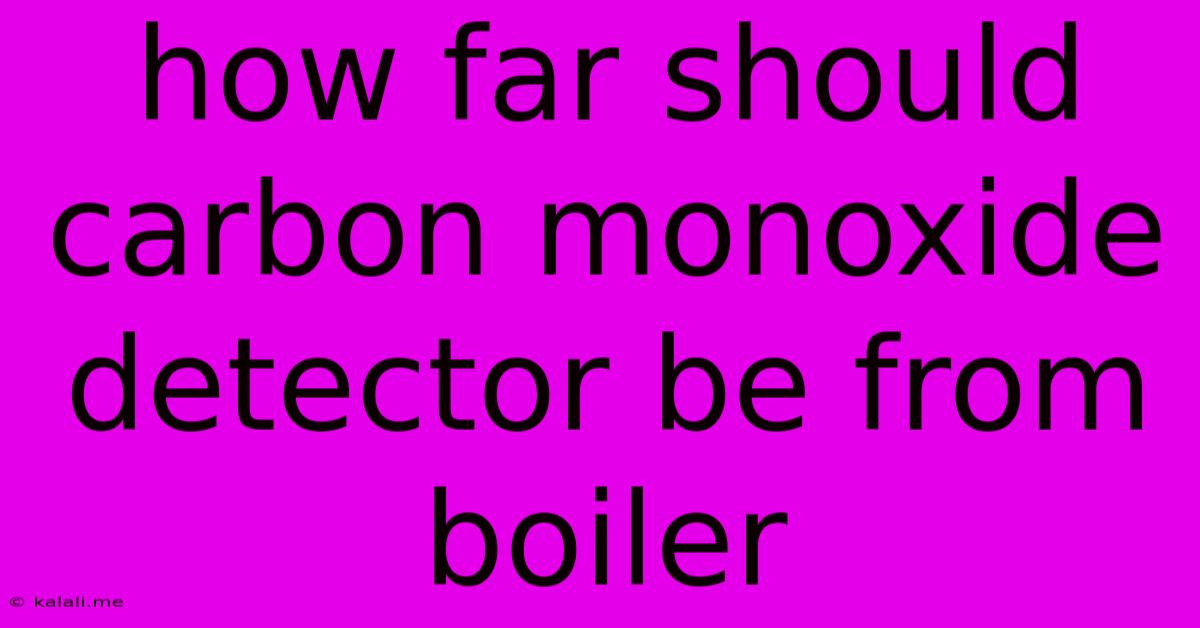How Far Should Carbon Monoxide Detector Be From Boiler
Kalali
May 21, 2025 · 3 min read

Table of Contents
How Far Should a Carbon Monoxide Detector Be From a Boiler? A Comprehensive Guide
Meta Description: Learn the optimal placement of carbon monoxide (CO) detectors in relation to your boiler to ensure maximum safety and effectiveness. This guide covers ideal distances, common mistakes, and crucial considerations for home safety.
Carbon monoxide (CO) is a silent killer, an odorless, colorless gas that can be lethal. Boilers, while essential for heating, are a potential source of CO leaks if malfunctioning or poorly maintained. Therefore, strategically placing your CO detectors is paramount for protecting your family's health. But how far should a carbon monoxide detector be from a boiler? The answer isn't a simple number, but rather a combination of factors that ensure optimal detection.
Understanding CO Detector Placement
The key isn't just distance from the boiler, but rather ensuring the detector is in a position to detect CO before it reaches dangerous levels in living spaces. This means considering airflow and the potential pathways CO could take.
Recommended Distance and Placement Guidelines
While there isn't a universally mandated distance, experts generally recommend the following guidelines:
- At least 10 feet (3 meters) away from any potential CO source: This includes boilers, furnaces, gas stoves, fireplaces, and any other appliance that burns fuel. This distance provides a buffer to allow for effective detection before CO concentration becomes dangerously high near the appliance.
- Place detectors on each level of your home: CO rises, so having detectors on every floor ensures comprehensive coverage. Prioritize areas where people sleep as CO poisoning is more dangerous during sleep.
- Install detectors in hallways or central locations: This maximizes the area covered by each detector and increases the chances of early detection, even if the leak originates further away from the device.
- Mount detectors on walls, approximately 5 feet (1.5 meters) from the floor: This height ensures the detectors are placed within the breathing zone.
- Avoid placing detectors in areas with high humidity or extreme temperatures: These conditions can affect the detector's accuracy and lifespan.
Common Mistakes to Avoid
- Placing detectors too close to the boiler: This may result in delayed detection, as high concentrations of CO might build up around the appliance before being detected.
- Installing only one detector: Multiple detectors, strategically placed, provide significantly better protection, particularly in larger homes with multiple floors or potential CO sources.
- Ignoring manufacturer's instructions: Always follow the specific instructions provided with your CO detector for optimal installation and operation.
- Neglecting regular testing and maintenance: Regularly test your detectors and replace batteries or the entire unit as recommended.
Factors Affecting Optimal Distance
Several factors can influence the ideal distance, including:
- Boiler type and size: Larger boilers or those with potential for larger leaks may require a greater distance.
- Home layout and ventilation: The airflow in your home will affect how quickly CO disperses. Well-ventilated homes may allow for slightly closer placement, but caution is always advised.
- Number and placement of other CO sources: If you have multiple potential sources of CO, you'll need more detectors, spaced strategically throughout your home.
Beyond Distance: Maintaining Your Boiler
Regular maintenance of your boiler is just as crucial as proper CO detector placement. A well-maintained boiler is less likely to produce dangerous levels of CO. Schedule annual inspections by a qualified technician to ensure your boiler operates safely and efficiently.
By following these guidelines and prioritizing regular maintenance, you can significantly reduce the risk of CO poisoning and protect your family from this invisible danger. Remember, early detection is crucial. Invest in quality detectors, install them correctly, and regularly check their functionality—your safety is paramount.
Latest Posts
Latest Posts
-
How To Get Oil Off A Wall
May 21, 2025
-
Do Men Prefer Women With Long Hair
May 21, 2025
-
What Is The Opposite Of Purple
May 21, 2025
-
At The Gym Or In The Gym
May 21, 2025
-
How Long Does It Take To Preheat Oven
May 21, 2025
Related Post
Thank you for visiting our website which covers about How Far Should Carbon Monoxide Detector Be From Boiler . We hope the information provided has been useful to you. Feel free to contact us if you have any questions or need further assistance. See you next time and don't miss to bookmark.